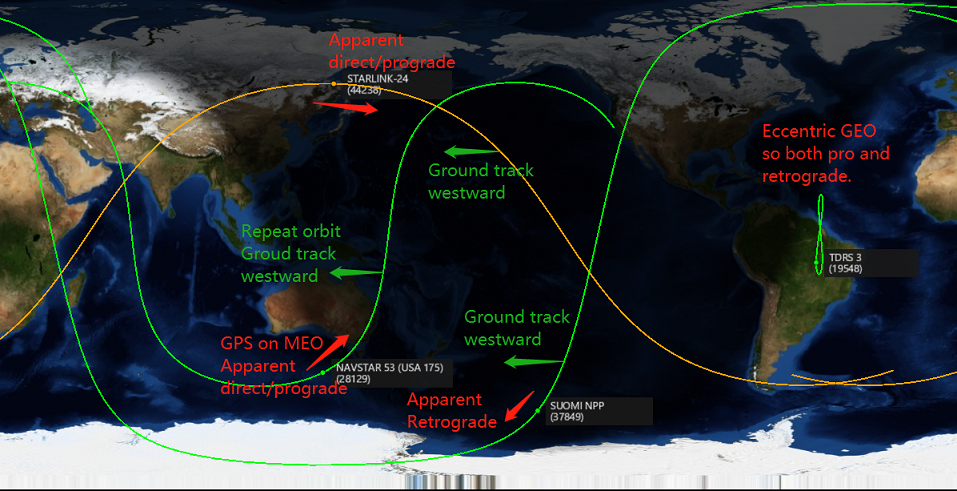Table of Contents
Ground track motion

Apparent motion on the 2D map
The orbit precession direction (always toward west) is different from the moving direction of the subsatellite point (depending on inclination $i$ as well as eccentricity $e$ and semimajor axis $a$). (Not quite correct.)
The apparent westward movement of the ground track (as a whole) occurs when nodal precession is slower than Earth rotation.
This is different from the apparent direct or retrograde motion of satellite on the ground track (not the movement of the ground track itself). “Apparent movement” is more about relative rotation speed of satellite w.r.t. the ground. “Apparent movement” has little to do with “nodal precession” simply because “precession” is slow (it has effect but not dominates the movement). Move eastward (apparent direct/prograde) if
- $e\approx 0$, $i < 90^\circ$ (a true direct orbit) and period < 24 hrs
- because Earth rotates eastward slower, needing 24 hrs
Move westward $\rightarrow$ (apparent retrograde) if
- $i > 90^\circ$ (a true retrograde orbit), or
- $e\approx 0$, $i < 90^\circ$ (a true prograde one), but period > 24 hrs, or
- because Earth rotates eastward faster
- $e > 0$, $i < 90^\circ$ depends
- because speed is varying on an eccentric orbit
- when falls in this case, the ground track folds and crosses itself, e.g., Molniya orbit; some GEO with a figure-8 ground track; etc.
“True direct/prograde” means same to the Earth rotation, eastward;
“True retrograde” means opposite to the Earth roataion, westward.
Orbit/Nodal Precession on the 2D map
The orbit precession is not obvious from the ground track plot. It doesn't determine the westward motion of track, but can adjust the speed to achieve particular objects, like SSO, repeat orbit, etc.
This motion is usually referred to as “drift” or “shift”.
Most of the ground track is moving westward (the track as a whole, not the satellite's motion on the track), because:
- True direct/prograde, $i<90^\circ$, precesses westward; Earth rotates eastward; relative motion of the orbit plan is always westward, regardless of the projected shape of the ground track.
- True retrograde, $i>90^\circ$, precesses eastward, but it must has a greater speed than the Earth rotation in order to show a eastward motion of the track, which is not likely unless in very extreme conditions.
- Search for “repeat orbit” for more discussions.
- GPS on MEO has a repeat ground track, which appears fixed but actually moves westward $180^\circ$ every revolution.